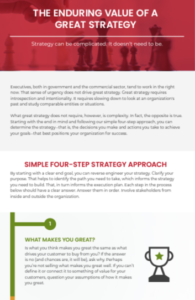The Enduring Value of a Simple Strategy

 Executives, both in government and the commercial sector, tend to work in the right now. That sense of urgency does not drive great strategy. Great strategy requires introspection and intentionality. It requires slowing down to look at an organization’s past and study comparable entities or situations. What great strategy does not require, however, is complexity. In fact, the opposite is true. Starting with the end in mind and following our simple four-step approach, you can determine the strategy–that is, the decisions you make and actions you take to achieve your goals–that best positions your organization for success.
Executives, both in government and the commercial sector, tend to work in the right now. That sense of urgency does not drive great strategy. Great strategy requires introspection and intentionality. It requires slowing down to look at an organization’s past and study comparable entities or situations. What great strategy does not require, however, is complexity. In fact, the opposite is true. Starting with the end in mind and following our simple four-step approach, you can determine the strategy–that is, the decisions you make and actions you take to achieve your goals–that best positions your organization for success.
Keep reading to learn more or download our four steps here.
A Simple Four-Step Approach to Strategy
By starting with a clear end goal, you can reverse engineer your strategy. Clarify your purpose. That helps to identify the path you need to take, which informs the strategy you need to build. That, in turn informs the execution plan. Each step in the process below should have a clear answer. Answer them in order. Involve stakeholders from inside and outside the organization.
1. What Makes You Great?
Is what you think makes you great the same as what drives your customer to buy from you? If the answer is no (and chances are, it will be), ask why. Perhaps you’re not selling what makes you great well. If you can’t define it or connect it to something of value for your customers, question your assumptions of how it makes you great.
2. What Are Your Competitors Doing?
Answering this question starts with defining your market. Know your competitors – who are they, what do they do, why do they win? Do they see you as being in this market? Then ask the key question: how are you better?
3. What Data Can Inform Your Strategy?
Who are your new buyers? Who are your repeat buyers? Where are your areas of growth or loss? Bring internal and external data together – market trends, buying patterns, pipeline productivity, year-over-year growth, and any data you have on competitors and the market. More objective data is better; it helps overcome bias and get to ground truth as you continue the process.
This data varies for each organization. This step is less about developing metrics and more about ensuring your people are using quality data to inform and drive strategy development.
4. Use that Collected, Flowing Data to Spot Patterns.
What patterns exist in the data gathered? Does it support your assumptions about what makes you great or what your competitors are doing? Use this step to get to ground truth and make informed decisions about future strategy.
Myopathy is a risk, so bring in advisors, board members, and other objective parties to help you spot patterns and decipher their meaning. Consider that luck and externalities play a role in your patterns. Question what the patterns mean. Do they reinforce or contradict what you think makes you great, or assumptions about competitors?
A Strategy Based in Reality Positions Your Organization for Success
The answers from these apparently simple considerations ground you in reality. They force you to understand what actually works and why. Chances are, you’ll see that many things just happen. You’ll be impacted by externalities that put you on an unanticipated path. Just because something worked or didn’t work once, it doesn’t mean the same result will happen again. That grounding in reality helps you adjust and adapt as you set your strategy in place.
- Categories
- Strategic Planning


 About the Authors
About the Authors